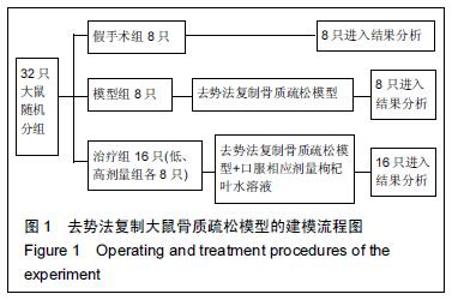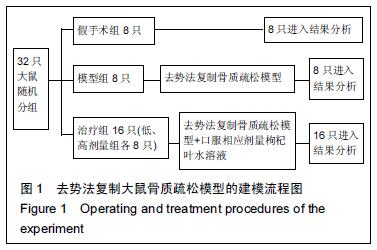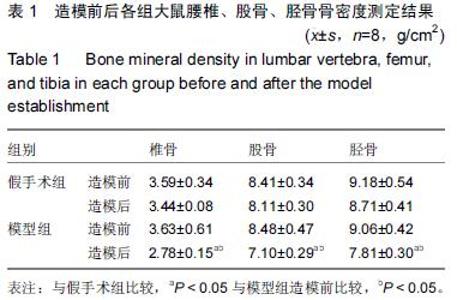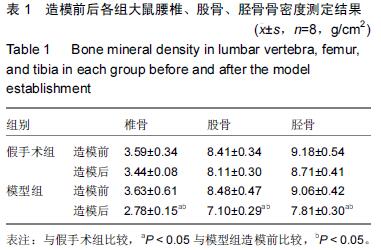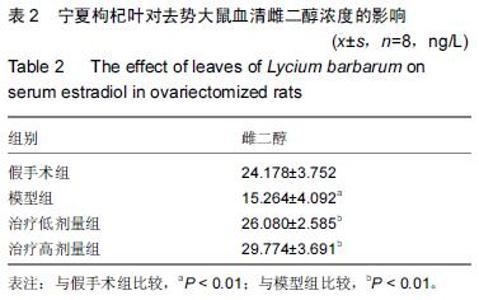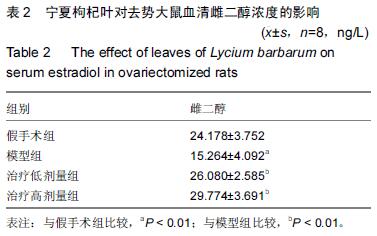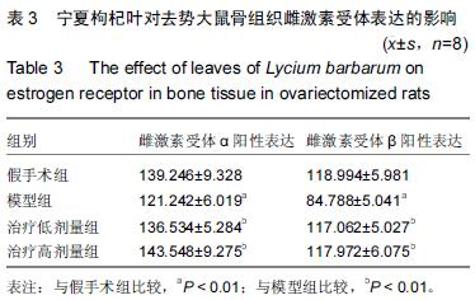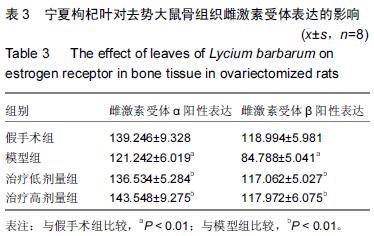| [1] 赵冀伟.骨质疏松药物治疗概述[J].天津药学,2004,16(2): 683. [2] Knusten R,Honda Y,Strong DO,et al.Regulation of IGF system components by OP-1 (0steogenic Protein-1) in human bone.Endocrinology.1995;l36:857. [3] 于世风. 骨吸收与骨形成[J].现代康复,2001,5(2):10. [4] Wang ZR. Correlation between estrogen receptor gene polymorphism and bone mineral density in elderly women.Zhongguo Zuzhi Gongcheng Yanjiu. 2015; 19(2):182-186. [5] 汪婷婷,罗维早.治疗骨质疏松的中药研究进展[J].现代中药研究及进展,2007,22(2):55-59. [6] 苗珍花,王杰,任萌萌,等.枸杞叶及枸杞多糖对去势雌性大鼠骨密度的影响[J].宁夏医科大学学报,2015,37(3): 233-236. [7] 李振甲.激素的放射免疫分析[M]北京: 科学技术出版社, 1985:10-13. [8] 程群,朱汉民.建立骨质疏松动物模型的标准化问题[J]. 老年医学与保健, 2003,9(2):122-124. [9] 王晓,梅其炳,刘莉,等.骨质疏松动物模型的复制与评价[J].中国骨质疏松杂志,2007,13(2):141-145. [10] 王立童,詹红.原发性骨质疏松动物模型的复制及其机制[J].亚太传统医药,2009,5(8):178-180. [11] 刘晓青,崔燎,吴铁.双侧卵巢切除大鼠不同时间段骨形态计量学参数的观察[J]中国骨质疏松杂志,2005,11(4): 427-429. [12] Siddiqui NI,Rahman S,Mia AR,et al.Evaluation of hormone replacement therapy. Mymensingh Med J. 2005;14(2):212-218. [13] 许咏乐.雌激素受体与绝经后骨质疏松[J].国外医学•妇产科分册,2005,32(5):274-277. [14] 向旭华.雌激素受体与绝经后骨质疏松症[J].中国组织工程研究与临床康复,2008,37(9):7398-7400. [15] Sumito O,Masayo F,Yasunori I.et al.Impaired estrogen sensitivity in bone by inhibiting both estrogen receptor α and β pathway.J Biol Chem. 2000;275(28):21372-21379. [16] Brend S,Mario XY.Repression of the interleukin一6 promotor by estrogen receptor is mediated by NF-kB and C/EBPβ.Mol Cell Biol.1995;15(9):4971. [17] Wang ZR. Age difference of estrogen receptor gene polymorphisms in the elderly women with hip osteoporosis.Zhongguo Zuzhi Gongcheng Yanjiu. 2015;19(7):991-995. [18] 郭志刚,郑华,吴赛珠,等.雌激素受体基因多态性与冠心病的关系[J].中华老年心脑血管病杂志,2002,4(6):22-24. [19] 龙晓宇,关咏梅.子宫内膜异位症患者异位内膜间质细胞雌激素受体-a、雌激素受体-β的表达[J].实用医学杂志, 2008,24(18):49-50. [20] Kusec V,Virdi AS,Prince R,et al.Localization of estrogen receptor-alpha in human and rabbit skeletal tissues. Clin Endocrinol Metab.1998;83:2421-2428. [21] Martin-Millan M, Almeida M, Ambrogini E, et al. The estrogen receptor-alpha in osteoclasts mediates the protective effects of estrogens on cancellous but not cortical bone.Mol Endocrinol.2010;24:323-334. [22] Nakamura T,Imai Y,Matsumoto T,et al. Estrogen prevents bone loss via estrogen receptor alpha and induction of Fas ligand in osteoclasts.Cell.2007; 130: 811-823. [23] 郑燕,朱小春,章振林.雌激素受体基因多态性与绝经后女性骨质疏松症雷洛昔芬治疗效果的关系研究[J].中国全科医学,2015,18(6):640-644. [24] 马锋,高俊,沈军,等.含枸杞多糖血清对 MC3T3-E1成骨细胞增值、分化和矿化的影响[J],宁夏医学杂志, 2012, 34(2):108-111. [25] 马锋,高俊,王一农,等.枸杞多糖含药血清对MC3T3-E1细胞内Ca2+及Ⅰ型胶原蛋白合成的影响[J].中国组织工程研究,2012,16(20):3743-3746. [26] 孙伟,苗珍花,王亚娜,等.宁夏枸杞全果对自然衰老小鼠认知及其脑组织中a7nAChR表达的影响[J].山东医药, 2010, 50(30):31-33. |
